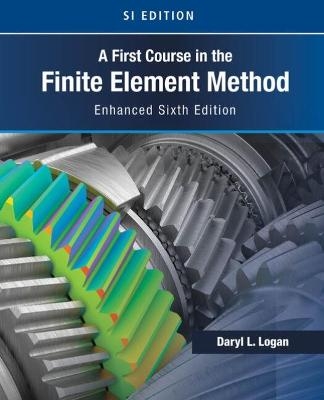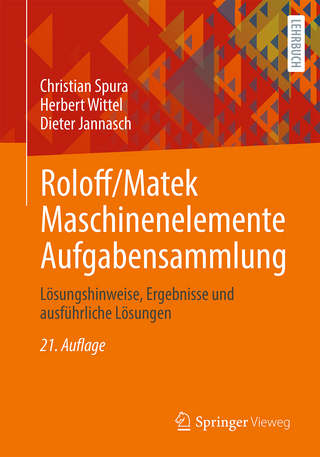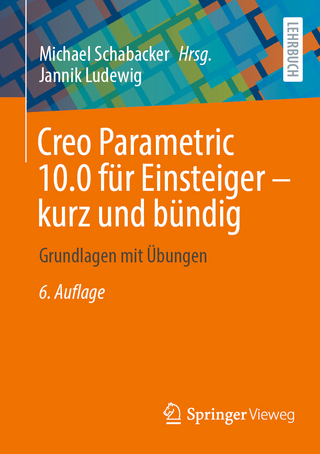
A First Course in the Finite Element Method, Enhanced Edition, SI Version
CL Engineering (Verlag)
978-0-357-67643-1 (ISBN)
Dr. Daryl L. Logan is professor of mechanical engineering at the University of Wisconsin-Platteville. He received his Ph.D. from the University of Illinois-Chicago. He has been an active member of the American Society of Mechanical Engineers (ASME), Tau Beta Pi - National Honor Society and the American Society for Engineering Education (ASEE). Dr. Logan holds a professional engineer's license in the state of Indiana.
1. INTRODUCTION.
Brief History. Introduction to Matrix Notation. Role of the Computer. General Steps of the Finite Element Method. Applications of the Finite Element Method. Advantages of the Finite Element Method. Computer Programs for the Finite Element Method.
2. INTRODUCTION TO THE STIFFNESS (DISPLACEMENT) METHOD.
Definition of the Stiffness Matrix. Derivation of the Stiffness Matrix for a Spring Element. Example of a Spring Assemblage. Assembling the Total Stiffness Matrix by Superposition (Direct Stiffness Method). Boundary Conditions. Potential Energy Approach to Derive Spring Element Equations.
3. DEVELOPMENT OF TRUSS EQUATIONS.
Derivation of the Stiffness Matrix for a Bar Element in Local Coordinates. Selecting Approximation Functions for Displacements. Transformation of Vectors in Two Dimensions. Global Stiffness Matrix for Bar Arbitrarily Oriented in the Plane. Computation of Stress for a Bar in the x-y Plane. Solution of a Plane Truss. Transformation Matrix and Stiffness Matrix for a Bar in Three-Dimensional Space. Use of Symmetry in Structure. Inclined, or Skewed, Supports. Potential Energy Approach to Derive Bar Element Equations. Comparison of Finite Element Solution to Exact Solution for Bar. Galerkin's Residual Method and Its Use to Derive the One-Dimensional Bar Element Equations. Other Residual Methods and Their Application to a One-Dimensional Bar Problem. Flowchart for Solutions of Three-Dimensional Truss Problems. Computer Program Assisted Step-by-Step Solution for Truss Problem.
4. DEVELOPMENT OF BEAM EQUATIONS.
Beam Stiffness. Example of Assemblage of Beam Stiffness Matrices. Examples of Beam Analysis Using the Direct Stiffness Method. Distribution Loading. Comparison of the Finite Element Solution to the Exact Solution for a Beam. Beam Element with Nodal Hinge. Potential Energy Approach to Derive Beam Element Equations. Galerkin's Method for Deriving Beam Element Equations.
5. FRAME AND GRID EQUATIONS.
Two-Dimensional Arbitrarily Oriented Beam Element. Rigid Plane Frame Examples. Inclined or Skewed Supports - Frame Element. Grid Equations. Beam Element Arbitrarily Oriented in Space. Concept of Substructure Analysis.
6. DEVELOPMENT OF THE PLANE STRESS AND STRAIN STIFFNESS EQUATIONS.
Basic Concepts of Plane Stress and Plane Strain. Derivation of the Constant-Strain Triangular Element Stiffness Matrix and Equations. Treatment of Body and Surface Forces. Explicit Expression for the Constant-Strain Triangle Stiffness Matrix. Finite Element Solution of a Plane Stress Problem. Rectangular Plane Element (Bilinear Rectangle, Q4).
7. PRACTICAL CONSIDERATIONS IN MODELING: INTERPRETING RESULTS AND EXAMPLES OF PLANE STRESS-STRAIN ANALYSIS.
Finite Element Modeling. Equilibrium and Compatibility of Finite Element Results. Convergence of Solution. Interpretation of Stresses. Static Condensation. Flowchart for the Solution of Plane Stress-Strain Problems. Computer Program-Assisted Step-by-Step Solution, Other Models, and Results for Plane Stress-Strain Problems.
8. DEVELOPMENT OF THE LINEAR-STRAIN TRIANGLE EQUATIONS.
Derivation of the Linear-Strain Triangular Element Stiffness Matrix and Equations. Example of LST Stiffness Determination. Comparison of Elements.
9. AXISYMMETRIC ELEMENTS.
Derivation of the Stiffness Matrix. Solution of an Axisymmetric Pressure Vessel. Applications of Axisymmetric Elements.
10. ISOPARAMETRIC FORMULATION.
Isoparametric Formulation of the Bar Element Stiffness Matrix. Isoparametric Formulation of the Plane Quadrilateral Element Stiffness Matrix. Newton-Cotes and Gaussian Quadrature. Evaluation of the Stiffness Matrix and Stress Matrix by Gaussian Quadrature. Higher-Order Shape Functions.
11. THREE-DIMENSIONAL STRESS ANALYSIS.
Three-Dimensional Stress and Strain. Tetrahedral Element. Isoparametric Formulation and Hexahedral Element.
12. PLATE BENDING ELEMENT.
Basic Concepts of Plate Bending. Derivation of a Plate Bending Element Stiffness Matrix and Equations. Some Plate Element Numerical Comparisons. Computer Solutions for Plate Bending Problems.
13. HEAT TRANSFER AND MASS TRANSPORT.
Derivation of the Basic Differential Equation. Heat Transfer with Convection. Typical Units; Thermal Conductivities, K; and Heat-Transfer Coefficients, h. One-Dimensional Finite Element Formulation Using a Variational Method. Two-Dimensional Finite Element Formulation. Line or Point Sources. Three-Dimensional Heat Transfer by the Finite Element Method. One-Dimensional Heat Transfer with Mass Transport. Finite Element Formulation of Heat Transfer with Mass Transport by Galerkin's Method. Flowchart and Examples of a Heat-Transfer Program.
14. FLUID FLOW IN POROUS MEDIA AND THROUGH HYDRAULIC NETWORKS; AND ELECTRICAL NETWORKS AND ELECTROSTATICS.
Derivation of the Basic Differential Equations. One-Dimensional Finite Element Formulation. Two-Dimensional Finite Element Formulation. Flowchart and Example of a Fluid-Flow Program. Electrical Networks. Electrostatics.
15. THERMAL STRESS.
Formulation of the Thermal Stress Problem and Examples.
16. STRUCTURAL DYNAMICS AND TIME-DEPENDENT HEAT TRANSFER
Dynamics of a Spring-Mass System. Direct Derivation of the Bar Element Equations. Numerical Integration in Time. Natural Frequencies of a One-Dimensional Bar. Time-Dependent One-Dimensional Bar Analysis. Beam Element Mass Matrices and Natural Frequencies. Truss, Plane Frame, Plane Stress, Plane Strain, Axisymmetric, and Solid Element Mass Matrices. Time-Dependent Heat-Transfer. Computer Program Example Solutions for Structural Dynamics.
APPENDIX A: MATRIX ALGEBRA.
Definition of a Matrix. Matrix Operations. Cofactor of Adjoint Method to Determine the Inverse of a Matrix. Inverse of a Matrix by Row Reduction. Properties of Stiffness Matrices.
APPENDIX B: METHODS FOR SOLUTION OF SIMULTANEOUS LINEAR EQUATIONS.
Introduction. General Form of the Equations. Uniqueness, Nonuniqueness, and Nonexistence of Solution. Methods for Solving Linear Algebraic Equations. Banded-Symmetric Matrices, Bandwidth, Skyline, and Wavefront Methods.
APPENDIX C: EQUATIONS FOR ELASTICITY THEORY.
Introduction. Differential Equations of Equilibrium. Strain/Displacement and Compatibility Equations. Stress-Strain Relationships.
APPENDIX D: EQUIVALENT NODAL FORCES.
APPENDIX E: PRINCIPLE OF VIRTUAL WORK.
APPENDIX F: PROPERTIES OF STRUCTURAL STEEL AND ALUMINUM SHAPES.
ANSWERS TO SELECTED PROBLEMS.
INDEX.
| Erscheinungsdatum | 15.03.2022 |
|---|---|
| Sprache | englisch |
| Maße | 188 x 232 mm |
| Gewicht | 1293 g |
| Themenwelt | Technik ► Maschinenbau |
| ISBN-10 | 0-357-67643-2 / 0357676432 |
| ISBN-13 | 978-0-357-67643-1 / 9780357676431 |
| Zustand | Neuware |
| Haben Sie eine Frage zum Produkt? |
aus dem Bereich


